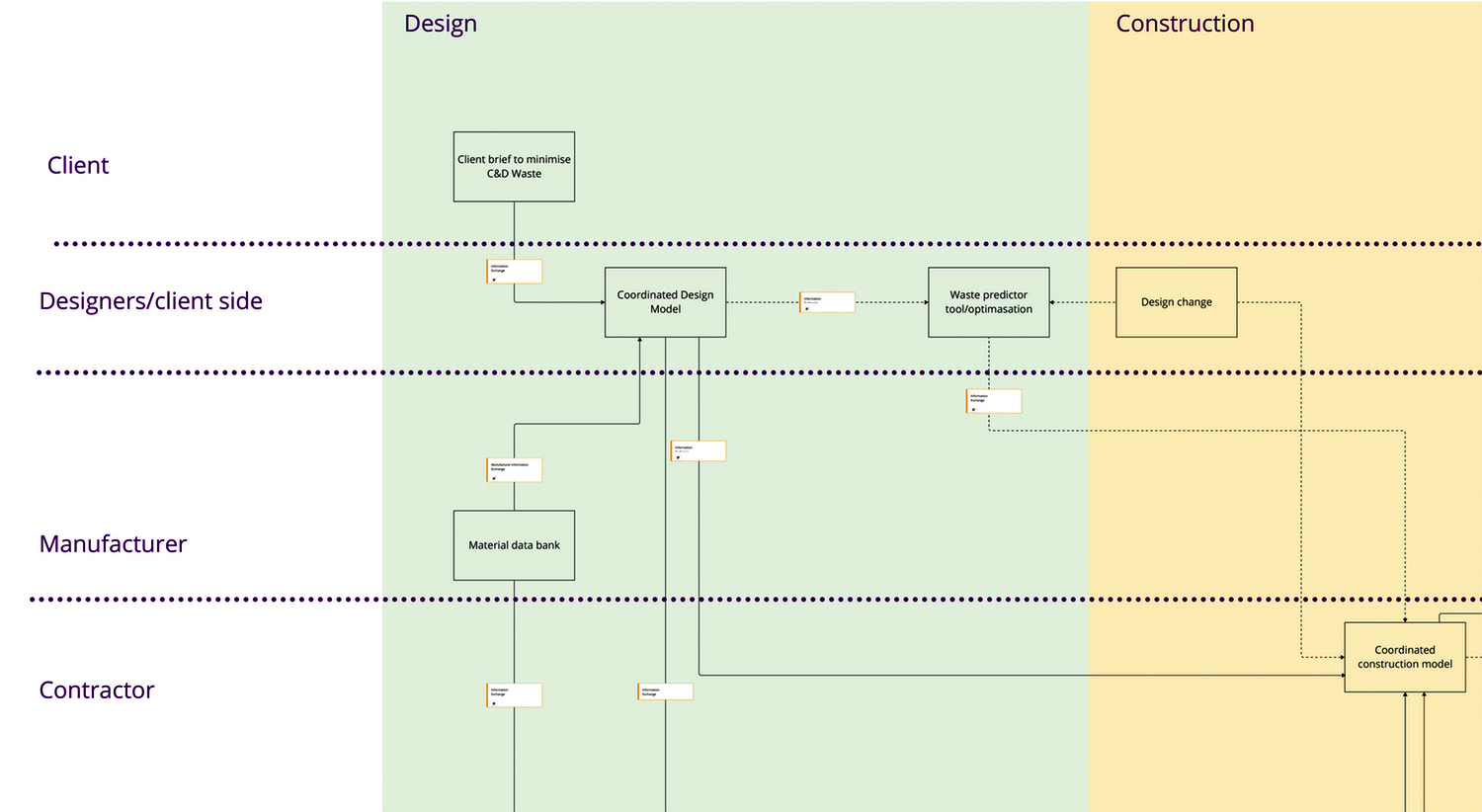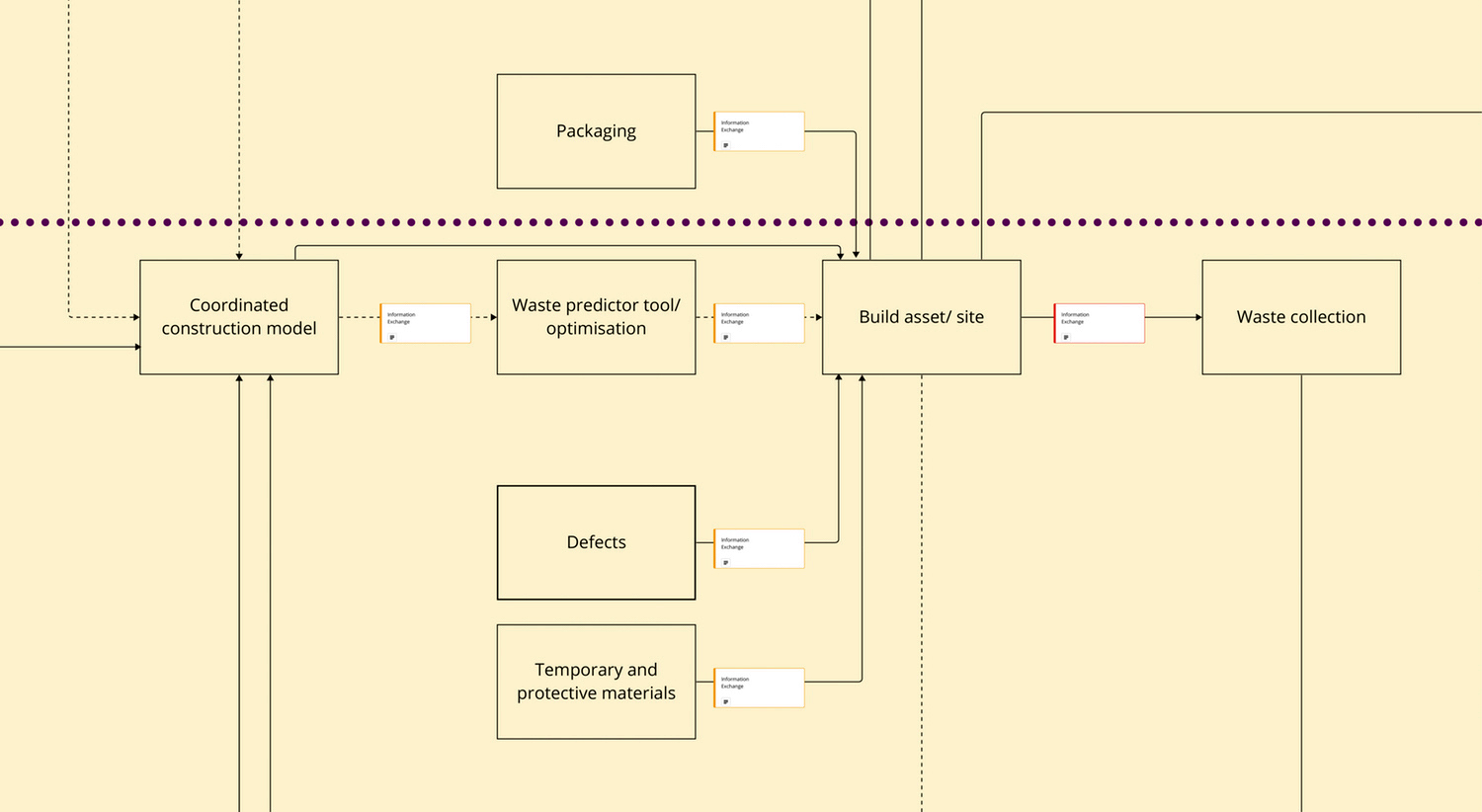
Welcome to the second instalment of BIMBox’s series on the development of WASTEie, a new dataset to standardise the exchange of construction and demolition (C&D) waste information.
Building upon the insights shared in the first article about WASTEie, which introduced the approach taken by the collaborative consortium of 23 global partners in Reconmatic, here we provide an update on progress with an exploration of the process map behind the upcoming specification and invite the industry to get involved.
When delving into the intricacies of C&D waste management, a comprehensive process map is a helpful guide in understanding the distinctions across the project lifecycle (note: we refer to material ‘waste’, otherwise known as ‘by-product’ etc). This should describe where and how to best facilitate information exchange.
Through the development of this process map, we have uncovered hidden complexities held within C&D waste management, leading to discovery, innovation and opportunities for sustainability that will be key to achieving circularity in the construction industry.
Unveiling the power of process maps
Drawing inspiration from the buildingSMART Information Delivery Manual, the Reconmatic team has identified three key steps in developing a specification for successful information exchange requirements:
- Define the scope (see our first article);
- Create a process map; and
- Write the specification.

Our scope is solely focused upon C&D waste information exchange. While this may, on first appearance, seem straightforward, navigating through the process map quickly reveals complexities.
So, what exactly is a process map?
Think of it as a treasure map, guiding us through a labyrinth of activities and events that shape the world of waste management. The process map serves as our compass, illuminating the path towards effective information exchange. In our case, we closely examine how waste is generated through a typical asset’s lifecycle. To set the framework, the team has identified project lifecycle stages, including design, construction, handover, maintenance, demolition and ‘circular economy’ stages.
Design and construction stages: architects of change
When crafting a comprehensive process map, the design and construction stages first emerge as critical stages in waste management. Our focus is on understanding the links between client requirements, coordinated models and the invaluable repository of material data banks, also known as product databases.
During the Reconmatic team’s exploration, it became clear that to maximise the potential of a product at the end of its life, we need access to robust manufacturer’s information, including insights into resource potential and essential product details. Fortunately, material passports, a brilliant concept from the Buildings as Material Banks project, already exist and serve as an excellent starting point for capturing vital product data (you can read more about the project and download its freely available data capture tool based on xml).
With every activity drawn, we are able to discern the responsible party for every task and event. This analysis has resulted in a list of 12 major actors who actively participate in waste management activities.

As we progress through the various stages of the waste cycle, we should also consider often overlooked factors such as packaging, defects and temporary materials. These items are not necessarily modelled in BIM authoring tools, yet significantly impact waste generation.

Maintenance stage: sustaining the built environment
Transitioning to the operations and maintenance stage, we enter a pivotal phase in the lifecycle of an asset. Here, our focus shifts towards product information and the essential knowledge needed for periodic replacement and safe disposal. Facility owners seek to maintain optimal functionality, making recyclability and manufacturers’ take-back schemes essential considerations.
In identifying the routes for product replacement, the Reconmatic team next explored the fate of the product at the end of its life. So far, we have identified three likely routes: manufacturer take-back schemes; reused product marketplace (if it exists); and waste transfer centres. It is clear how standardised data relating to these pathways can play a pivotal role in supporting their success, as these rely on the availability of accurate information regarding product origins, materials and end-of-life options to make informed decisions.
Demolition stage: unearthing hidden potential
As we approach the final stage of an asset’s life, the demolition or deconstruction stage emerges as a critical juncture. Here, the spotlight shifts from product details to the importance of material properties.
Excluding products that could be sent back to the manufacturer (if they still exist), or products that could be repurposed or reused, we are left with building materials that require investigation for their resource potential. This is where pre-demolition audits become invaluable.
At this point, physical, mechanical, chemical and historic information about the material takes precedence. Given that an asset’s lifespan can be 50 or even 100 years, the information gathered during design and construction might become outdated due to environmental impacts altering material properties. For this reason, samples are taken to laboratories to test the material prior to assigning end-of life options, essentially, striving to minimise landfill waste through more informed decision-making.
Conclusion
With the process map as our guide, the development of WASTEie is gaining momentum. Having illuminated the intricacies of waste generation and reduction, we are able to identify what information will have a positive impact in the C&D waste information exchange process, with a path towards a circular economy increasingly clear. Please join our journey of research and collaboration, as we strive to build a sustainable future for generations to come.
Join the movement: engage and inspire
Our process map represents the initial iteration of our journey, yet we recognise its continuous evolution. We invite you to contribute by providing feedback and insights from your industry perspective. Explore our work in progress and share your thoughts on our open Miro board, a collaborative space designed to foster innovation and facilitate impactful change. This collective input will be helpful for us to shape the future of waste management in a way that is practical and useful for everyone.
Vitalij Tetervov and Chris Crookes are R&D manager and MD respectively of BIMBox, part of the Reconmatic consortium working to establish practical methods to better identify and minimise C&D waste during the entire lifecycle of a building.
Don’t miss out on BIM and digital construction news: sign up to receive the BIMplus newsletter.











